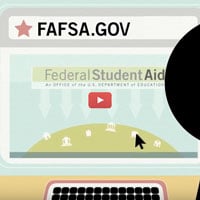Financial Aid
It is crucial that youth and families begin planning for how postsecondary education costs will be covered as early as possible. This includes knowing when to submit financial aid paperwork, accessing programs that may help cover certain costs and using other savings strategies.
Videos

College Costs: Net Price Calculator

Overview of the Financial Aid Process

After the FAFSA: What Happens Next
For more videos on this topic, visit our Videos page.
Did you find this helpful?
Resources
- FAFSA On the Web
The Free Application for Federal Student Aid (FAFSA) is the place to start your search for financial aid for your postsecondary education. - Guide to Paying for College for Students with Disabilities | Affordable Colleges Online
This guide explains federal aid options, discusses subsidized and unsubsidized loans, and provides information on scholarships for students with disabilities.. - College Affordability and Transparency Center
This US Department of Education Web site helps students and their families determine which colleges have the highest and lowest tuition, how much career and vocational education programs cost, and how fast college costs going up. - College Funding for Students with Disabilities
Fact sheet from the University of Washington's DO-IT program - Paying for College: Exploring Funding Sources for an Inclusive Postsecondary Education Program.
This Think College article reviews a variety of possible funding sources for college that students with Intellectual Disabilities and their families can consider. - Senior Year Financial Aid Checklist
This checklist from the College Board was developed to guide high school students and their families about what they can do to prepare to fund their college education in the final year of high school. - Funding Your Education
Section of Minnesota's Disability 101: web site providing information to Minnesota youth with disabilities and their families looking at a variety of ways to pay for postsecondary education. - Scholarship Finder
This web page from the U.S. Department of Labor’s CareerOneStop site allows you to search more than 7,500 scholarships, fellowships, grants, and other financial aid award opportunities. - Scholarship.com
- Scholarships & Financial Aid for Students with Disabilities
This page allows users to search for scholarships available to students with specific disabilities such as autism or hearing, vision or speech disabilities and also provides general descriptions of federal financial aid programs. - Scholarships for Students with Disabilities | AffordableCollegesOnline.org
This page on the Affordable Colleges Online web site features selective scholarship opportunities that students with disabilities may apply for to help pay for school. - Student Aid.gov
A U.S. Department of Education web site that can provide students with an early estimate of their eligibility for federal student financial assistance and reduce the amount of time it will take to complete the Free Application for Federal Student Aid (FAFSA), the qualifying form for all federal student financial aid. - "Mapping Your Future"
A neutral, non-proprietary, and non-commercial Web site sponsored by student loan guaranty agencies – many of which are nonprofit or state agencies – from around the country. While not focused on disability issues, it provides resources on career selection, college planning, and money management tools helpful for all students and families. - NITRO Scholarship Opportunities for Students with Disabilities
This site is a free interactive online scholarship database that lets users sort through over 30 annual scholarships for individuals with disabilities.

